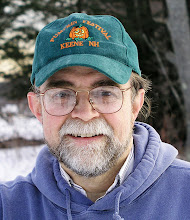
 |
| Lower Pasture Chesterfield, NH |
I hate to generalize, but for photography in
New England, summer is not my favorite season. Perhaps I expressed it best in a previous
article from the summer of 2017:
“It’s summer! Great! The days are
balmy, which is just a nicer way of saying hot and humid. The Black Flies
have been replaced by voracious Mosquitoes, and, if you want to see the
sunrise, you must drag yourself out of bed at 4:30 AM. It is wonderful to
see all the green, but the foliage has largely matured to the same monotonous shade
for maximal photosynthesis. BAH HUMBUG?”
 To be sure, I
enjoy the rich fragrant air with its sweet scents of fresh growth, and I will
admit that New England’s warm summer months hold their own visual attractions. Summer sunsets and sunrises can be dramatic,
as can the light during the changeable weather, from morning fog to afternoon
thunderstorms. I have always insisted
that, if we are prepared to accept what nature provides, all seasons and times
of day can provide photographic opportunities, but I get bored with the
persistent monochrome of green.
To be sure, I
enjoy the rich fragrant air with its sweet scents of fresh growth, and I will
admit that New England’s warm summer months hold their own visual attractions. Summer sunsets and sunrises can be dramatic,
as can the light during the changeable weather, from morning fog to afternoon
thunderstorms. I have always insisted
that, if we are prepared to accept what nature provides, all seasons and times
of day can provide photographic opportunities, but I get bored with the
persistent monochrome of green. Happily, summer offers another photographic attraction. All that green creates the perfect conditions for infrared photography.
 |
| Pasture Gate, Chesterfield NH |
 |
| Electromagnetic Spectrum https://www.miniphysics.com/electromagnetic-spectrum_25.html |
Infrared photography follows most of the rules of Black and White. Void of color, the visual impact depends on pattern and contrast.
 In previous articles, I have
discussed the effects of infrared light and how I modified my old Canon 20D to
become an infrared camera. What I wanted to do in this post was to share some of my infrared
images from this summer. Hopefully I can
inspire you to convert one of your old dust-collecting doorstops into an
infrared camera. LifePixel specializes in such conversions, and I was happy with their service. It is not expensive and
you will learn that there is much more to our world than can be seen through
the illusion created by our narrow visual spectrum.
In previous articles, I have
discussed the effects of infrared light and how I modified my old Canon 20D to
become an infrared camera. What I wanted to do in this post was to share some of my infrared
images from this summer. Hopefully I can
inspire you to convert one of your old dust-collecting doorstops into an
infrared camera. LifePixel specializes in such conversions, and I was happy with their service. It is not expensive and
you will learn that there is much more to our world than can be seen through
the illusion created by our narrow visual spectrum.



